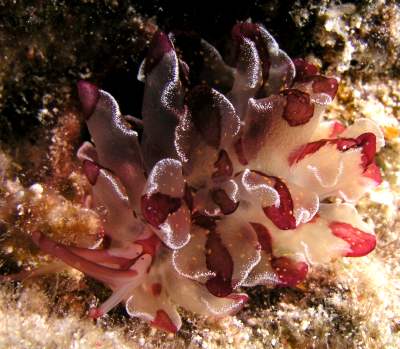
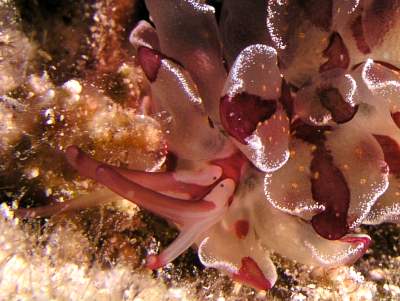
Cyerce cristallina
(Trinchese, 1881)
Order: SACOGLOSSA
Superfamily: LIMAPONTIOIDEA
Family: Caliphyllidae
DISTRIBUTION
Mediterranean & Caribbean
PHOTO
Cozumel Is., Yucatan Peninsula, Mexico. Depth: 20 feet. Approx 3 cm long. Photos: Jim Lyle
The body and inner part of the foot is a deep opaque red. There are a pair of ovate translucent clear patches on the head running from the eye to the base of the rhinophores, and another U-shaped translucent clear patch in the dorsal midline over the pericardial swelling. These three translucent patches leave a red cross-shaped pattern on the head. The edge of the foot is translucent clear. The larger branch of the bifid rhinophores is red while the smaller branch is translucent clear with a reddish tip. The oral tentacles are translucent. The cerata are translucent with a red marking down the midline, which can range from a broad band right down the ceras, to just a red patch at the tip. On each side of the red tip the ceratal edge is opaque white, with white specks scattered out on to the dorsal surface of the cerata. The foot as rounded front corners and the anterior edge is transversely grooved. The sole of the foot is crossed by a deep transverse furrow at the end of the first third of the body. Some descriptions report an olive-green band along the sides of the body, which may be food related but this is not clear from published descriptions. The anal papillae is situated on the right side, behind the eye and just ahead of the pericardium. The spawn is a flat spiral band with white eggs 0.06 in diameter. Grows to approximately 35mm in length.
The Caribbean specimen illustrated here has small raised yellow spots scattered over the dorsal surface of the cerata but these are not mentioned in any published descriptions of specimens. Thompson (1977, 1988) notes Cyerce jheringi Pelseneer, 1892 and Lobifera cristallina (Portmann,1958) as synonyms.
References:
• Schmekel, L. & Portmann, A. (1982) Opisthobranchia des Mittelmeeres. Nudibranchia und Sacoglossa. Springer-Verlag. 410pp.
• Thompson, T.E. (1977) Jamaican Opisthobranch Molluscs. I. Journal of Molluscan Studies 43: 93-140.
• Thompson, T.E. (1988) Eastern Mediterranean Opisthobranchia: Oxynoidae, Polybranchiidae, Stiligeridae (Sacoglossa. Journal of Molluscan Studies, 54: 157-172.
Rudman, W.B., 2003 (August 27) Cyerce cristallina (Trinchese, 1881). [In] Sea Slug Forum. Australian Museum, Sydney. Available from http://www.seaslugforum.net/find/cyercris
Related messages
Cyerce cristallina from Gallipoli - Lido Pizzo
October 29, 2008
From: Fabio Crocetta
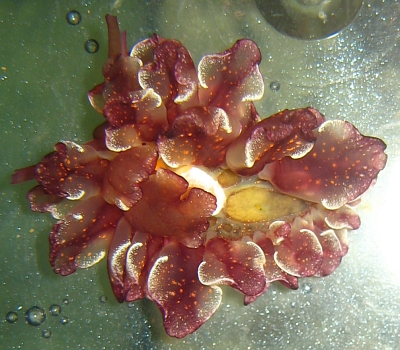
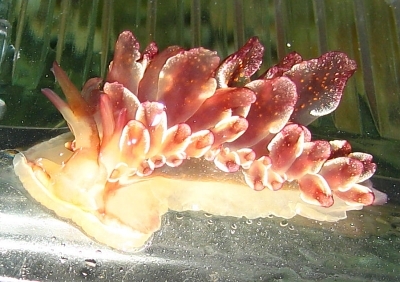
Dear Bill,
Thanks for your email identifying this species as Cyerce cristallina. Here are some photos of the animal which was found by my friend Giuseppe Colamonaco at 0.5 - 1 m of depth on a hard substrata at Gallipoli, near Lido Pizzo (LE), which is quite a small city in the Southern Italy (Mediterranean Sea). Photos were taken by Giuseppe in his private aquarium.
Best wishes,
Fabio Crocetta
fabiocrocetta@alice.it
Crocetta, F., 2008 (Oct 29) Cyerce cristallina from Gallipoli - Lido Pizzo. [Message in] Sea Slug Forum. Australian Museum, Sydney. Available from http://www.seaslugforum.net/find/21999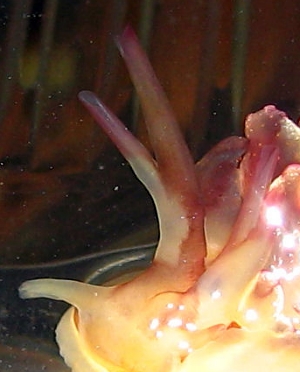
Dear Fabio,
Thanks for these photos. It's good to get records of this species and photos showing a slightly different colour form. The rolled tube-like rhinophores, which are each divided into two, is a clear indication that this is a specie sof Cyerce - a sacoglossan rather than an aeolid nudirbranch.
Best wishes,
Bill Rudman
Cyerce cristallina from Formiche di Grosseto
September 3, 2007
From: Elisabetta Guerrini
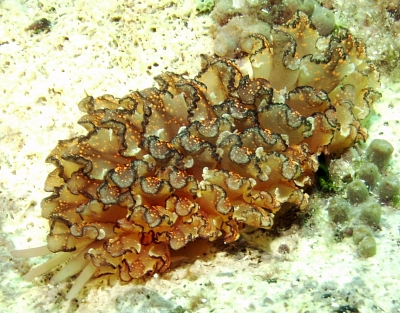
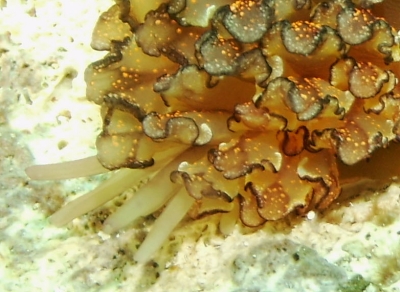
Dear Bill,
Thanks a lot for your opinion [message #20535 ]!
I'm sure you're right especially after I've seen the pictures in this message that Diego kindly forwarded me.
Locality: Formiche di Grosseto, 7.2 m, Italy, Tyrrhenian Sea, 19 August 2007. Length: about 4 cm. Photographer: Diego Daroczy
The "curled" cerata and the brown shade gave me the wrong impression that it could be more similar to a Polybranchia than a Cyerce cristallina, but looking carefully to these new images we can see a darker coloration of the two upper branches of the bifid rinophores, recognize a light-red patch at the tip of some ceras, the tiny white dots on the ceratal edge and admire the huge quantity of bright orange spots!
Friendly regards.
Lisa
.
bettonio@alice.it
Guerrini, E., 2007 (Sep 3) Cyerce cristallina from Formiche di Grosseto . [Message in] Sea Slug Forum. Australian Museum, Sydney. Available from http://www.seaslugforum.net/find/20622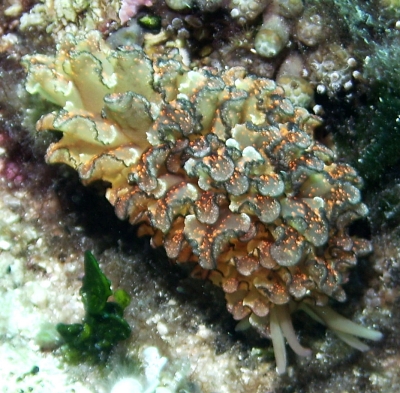
Thanks Lisa,
From my reading of the scientific literature I can't find any mention of the yellow-orange spots which link the animals with red marks and those without red marks. I would be interested in some comments from local experts
Best wishes,
Bill Rudman
New Polybranchia? in Mediterrean Sea
August 30, 2007
From: Elisabetta Guerrini
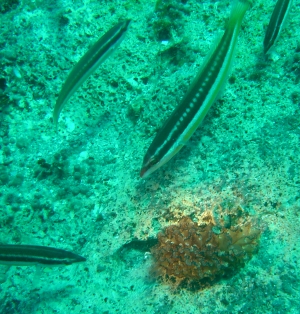
Dear Bill,
Please, tell me your opinion about this new friend found in Tirrenian Sea!
I think that it could be a Polybranchia but it sounds really strange for our area and it shows different coloration from all the others I saw in pictures.
Locality: Formiche di Grosseto, 7.2 m, Italy, Tirrenian Sea, 19 August 2007. Length: about 4 cm. Photographer: Elisabetta Guerrini.
Lisa
bettonio@alice.it
Guerrini, E., 2007 (Aug 30) New Polybranchia? in Mediterrean Sea. [Message in] Sea Slug Forum. Australian Museum, Sydney. Available from http://www.seaslugforum.net/find/20535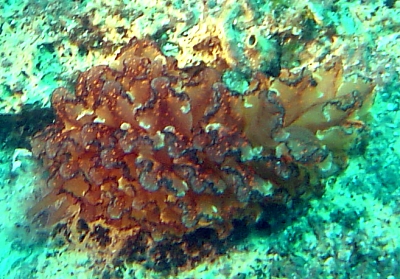
Dear Lisa,
I am pretty sure this is Cyerce cristallina, which is a genus closely related to Polybranchia.
Best wishes,
Bill Rudman
Cyerce cristallina from Croatia
August 28, 2006
From: Tom Turk
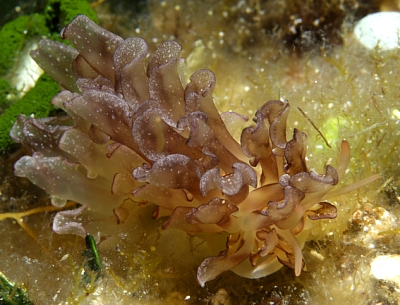
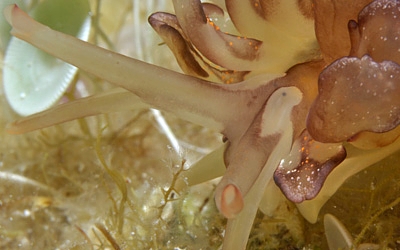
Dear Bill,
I am sending you two photos of the sea slug probably Cyerce cristallina. The photos were taken on a night dive on the rocky bottom covered with algae at the depth of approx 10 m. Location Susac Island, Croatia, Adriatic sea. According to the photographer the animals were 5 and 8(?) cm long. Could you confirm the species indentification.
Locality: Island Sušac, Adriatic sea, 10-12 m, Croatia, Adriatic, July, 2006, rocky gottom covered with algae. Length: 5, 8 and 20 cm. Photographer: Borut Furlan.
Best regards,
Tom Turk
tom.turk@bf.uni-lj.si
Turk, T., 2006 (Aug 28) Cyerce cristallina from Croatia. [Message in] Sea Slug Forum. Australian Museum, Sydney. Available from http://www.seaslugforum.net/find/17518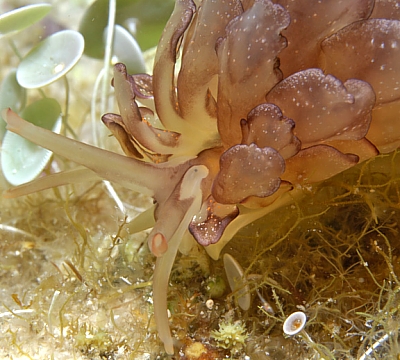
Dear Tom,
Thanks for these photos. It's good to get another example from the Mediterranean region. This is a much duller version of the species when compared with the wine red coloured 'typical' specimens we have on the Forum. The few patches of yellow spots on some of the anterior cerata clearly link this to the red patterned specimens. Looking at your photos, I am fairly confident an earlier message from Florida [#6047] is also this species.
Best wishes,
Bill Rudman
Cyerce cristallina from southern France
July 30, 2005
From: Fabien Lombard
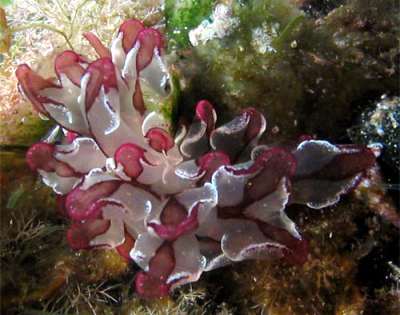
I've observed this opisthobranch in Villefranche sur mer (France, Mediterranean Sea) during a night dive at 7 metres depth. I think that it's Cyerce cristallina. I have never seen this species here before, and found no eggs or other specimens. I observed some yellow spots on the cerata but they were not as numerous as in the previous observations from Jim Lyle [message #10855 ]
Locality: Villefranche sur mer, France, Mediterranean Sea. Depth: 7 m. Length: 30 mm approximately 18 July 2005. grassy bottom. Photographer: Fabien Lombard
Fabien Lombard
lombard@obs-vlfr.fr
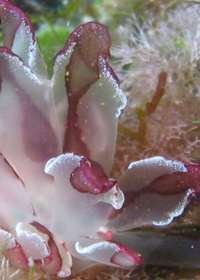
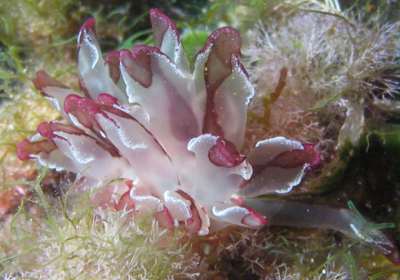
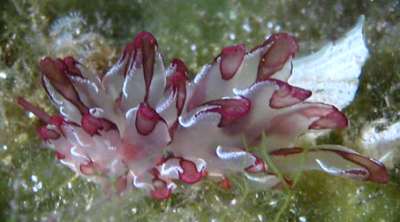
Dear Fabien,
Villefranche sur mer is a very famous locality, often mentioned by French opisthobranch workers as the source of their specimens.
It is good to get some photos of this beautiful animal from the Mediterranean to compare with Jim Lyle's from Mexico. The yellowish spots are almost certainly glands, so the difference in abundance may just reflect a difference in the physiological cycle of the glands.
Best wishes,
Bill Rudman
Cyerce cristallina from Cozumel, Mexico
August 29, 2003
From: Jim Lyle


We have seen very few nudibranchs in Cozumel Is. [Yucatan Peninsula, Mexico] over the years. The attached image shows what I believe to be Cyerce cristallina that we found on a shore night dive in 20 feet of water. We did not find any other specimens in the immediate area nor any recognizeable egg masses. This one was about 3 cm long and was light sensitive; crawling away from our lights if held too long.
Jim Lyle
jlyle@adelphia.net
Lyle, J., 2003 (Aug 29) Cyerce cristallina from Cozumel, Mexico. [Message in] Sea Slug Forum. Australian Museum, Sydney. Available from http://www.seaslugforum.net/find/10855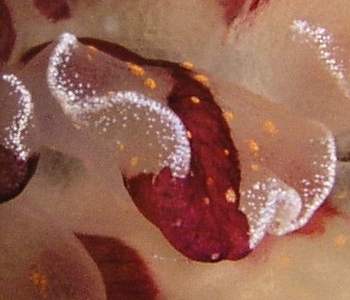
Dear Jim,
Thanks for this interesting record. The species of Cyerce and Polybranchia from the western Atlantic are not well known so photos such as yours are of great value in building up more information. For example I can't find any description which mentions the large raise yellow spots on the dorsal surface of the cerata, although there are mention of scattered white spots by some authors. This species was originally described from the Mediterranean, and so is what we call an amphi-Atlantic species, with populations on both sides of the warm-water Atlantic
Best wishes,
Bill Rudman
Cyerce cristallina? from Florida
January 26, 2002
From: Linda Ianniello
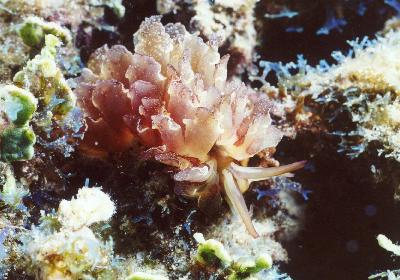
Bill,
Here is a photo of Cyerce cristallina from South Florida. It was found at night, off the shore of Deerfield Beach, at a depth of about 15 feet [5 meters]. We have found these animals several times, but they are very difficult to spot as they blend in so well with the surrounding algae. They also don't like light, and will crawl into a hole if the light is left on them for too long. This subject was about 1.5 inches long.
Linda Ianniello
lindai@us.ibm.com
Ianniello, L., 2002 (Jan 26) Cyerce cristallina? from Florida. [Message in] Sea Slug Forum. Australian Museum, Sydney. Available from http://www.seaslugforum.net/find/6047Dear Linda,
Thanks for this photo but I have some doubts about this identification. It is another example of the difficulty in identifying West Atlantic animals. Cyerce cristallina(Trinchese, 1881) was originally described from the Mediterranean and specimens from there have a very distinctive colouration. It has also been reported from the Caribbean by Thompson (1977) who reported four related species from Jamaica, Cyerce cristallina, Cyerce edmundsi, Cyerce antillensis, and Polybranchia viridis.
C. cristallina is translucent white with distinct reddish markings on the head and cerata. Thompson says the four species are easily distinguishable externally:
"Polybranchia viridis has tuberculate papillae, while those of the other three species of Cyerce lack tubercles. Cyerce edmundsi has pearl-like swellimg along the free oiuter edge of the cerata, lacking in the other two species. Cyerce cristallina has crimson markings on a white background, while Cyerce antillensis is predominantly drab brown in colour."
From his account I am pretty sure your animal is not C. cristallina but unfortunately I am not sure from the photo just which of the other three your animal is. Hopefully Kathe Jensen will have an idea.
• Thompson, T.E. (1977) Jamaican opisthobranch molluscs I. Journal of Molluscan Studies, 43(2): 93-139,pls.1-3.
Best wishes,
Bill Rudman
